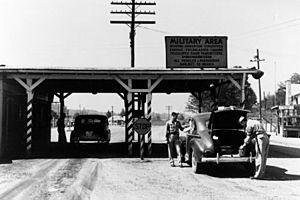Elza, Tennessee facts for kids
Elza was a small community in Anderson County, Tennessee. It existed before 1942. That's when the land was bought for a super-secret project called the Manhattan Project. Today, the area where Elza used to be is part of the city of Oak Ridge, Tennessee.
What Was Elza Like?
Elza grew up around a special train stop. This stop was on the Louisville and Nashville Railroad line. It was like a small village. Elza had a local country store where people could buy things. But it didn't have its own post office. Mail for Elza residents came through a nearby community called Dossett.
The name "Elza" came from a railroad engineer. His name was Paul Elza. He helped build the railroad. Materials for a bridge over the Clinch River and an underpass were marked "Elza." These materials were delivered to a shed near the train tracks. That's how the community got its name!
A famous musician, William "Fiddlin' Bill" Sievers, was born near Elza in 1875. He was an early country music guitarist. He was also part of a band called the Tennessee Ramblers.
Elza and the Secret Project
During World War II, the United States started a top-secret mission. It was called the Manhattan Project. This project aimed to build the first atomic bomb. When the government was looking for a place to build its new facilities, the area near Elza was chosen. This area became the secret city of Oak Ridge.
Elza became very important during the war. It was the location of one of the main security gates for Oak Ridge. Oak Ridge was a "closed city." This meant you needed special permission to enter or leave. The Elza gate was on the road from Clinton to Oak Ridge. It was the busiest and most public entrance. When Oak Ridge was finally opened to everyone in 1949, the special gate-opening ceremony happened right at the Elza gate.
Elza's Lasting Mark
Even after the community was gone, some things remained. The Luther Brannon House, built in 1941, was a building connected to the Elza community. It stood until 2021.
For many years after World War II, some warehouses in the Elza area were used for storage. They held materials like uranium ore. In the early 1990s, the government cleaned up the site. This was because the soil had been found to have some harmful chemicals.


